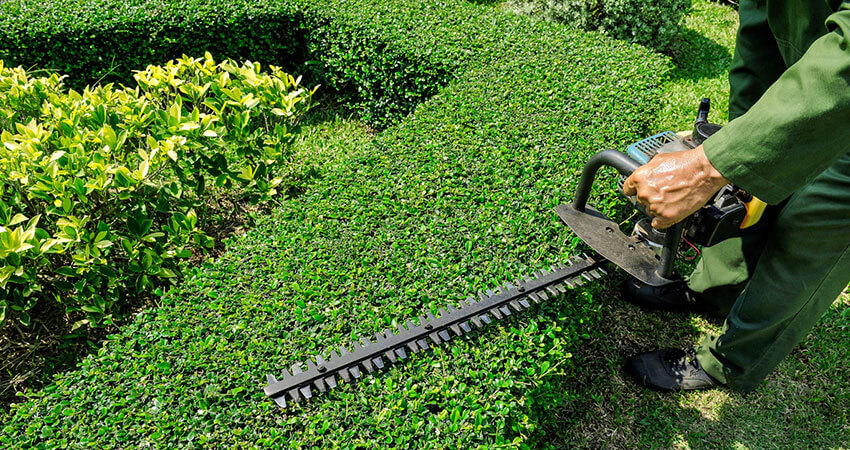Understanding the importance of commercial hedge trimming
When it comes to making a lasting impression, first impressions are paramount. The outdoor aesthetics of your business play a significant role in how potential customers perceive your brand. Commercial hedge trimming is more than just cutting back foliage; it’s about crafting an inviting atmosphere that reflects professionalism and care.
Well-maintained hedges can enhance the overall curb appeal of your property, setting the tone for a welcoming business environment. They frame your building, create a pleasing backdrop, and speak volumes about your attention to detail. Regular hedge trimming can transform an ordinary outdoor space into an extraordinary one.
The role of hedge trimming in business aesthetics
Hedges serve as natural barriers and decorative elements, guiding visitors and enhancing the look of your business premises. An overgrown or unkempt hedge can convey neglect and disarray, while neatly trimmed hedges exude a sense of professionalism. The ideal hedge shape and size can complement architectural features and landscaping, creating a cohesive and attractive appearance.
Moreover, trimmed hedges can improve visibility, making it easier for customers to find their way to your entrance. In a competitive market, the aesthetics of your business can differentiate you from others, making commercial hedge trimming an investment rather than just an expense.
How regular hedge maintenance impacts your business image
Regular hedge maintenance goes hand in hand with enhancing your business image. A well-kept exterior signals to clients that you care not only about your business but also about their experience within your premises. If hedges are left unattended, they can obstruct pathways or signage, creating confusion and frustration for customers.
On the other hand, consistent maintenance reinforces your brand’s commitment to quality and attention to detail. This simple act can lead to increased customer confidence, heightened employee morale, and even a boost in business revenue over time.
The process of commercial hedge trimming
Understanding the step-by-step process of commercial hedge trimming can ensure efficient results and maintain the health of your shrubs. Effective trimming requires planning and execution, taking into account the type, size, and species of hedges involved.
The process often begins with assessing the current state of the hedges. This includes identifying the specific growth patterns and health of the plants, as well as any structural issues that need addressing. From there, one can develop a trimming strategy tailored to the specific needs of the hedges.
Essential tools for effective hedge trimming
Equipped with the right tools, cutting your hedges can become a straightforward task. The essential tools for hedge trimming include:
- Hedge clippers: Both manual and power varieties are useful for different types of hedges.
- Pruning shears: Ideal for more detailed work, especially on smaller branches.
- Loppers: Perfect for reaching higher branches without the need for a ladder.
- Safety gear: Such as gloves, goggles, and hats to protect yourself while trimming.
Using the appropriate tools can make a significant difference in achieving a clean and professional finish. Moreover, regular maintenance of these tools ensures their longevity and effectiveness.

Techniques for achieving a professional finish
When it comes to trimming hedges, employing proper techniques is crucial. Start by trimming during the growing season, usually in spring or summer, to allow the plants to recover. Always aim to create a shape that reflects the natural growth of the plants, rather than forcing an unnatural shape.
Utilising techniques like the ‘box cut’ or ‘topiary style’ can yield pleasing results. It’s essential to trim a little at a time, checking your progress frequently to avoid over-trimming. Additionally, stepping back and observing your work from different angles can help ensure symmetry and balance.
Hiring professionals vs DIY hedge trimming
Deciding whether to hire professionals or attempt a DIY hedge trimming project requires careful consideration of your specific circumstances. Both approaches have their own benefits and drawbacks, depending primarily on factors like time, expertise, and budget.
Professional services bring experience and efficiency to the table, often resulting in a superior finish. They are well-versed in proper techniques and understand plant biology, ensuring that your hedges remain healthy even after trimming.
Evaluating the pros and cons of professional services
Hiring professionals can save you significant time and effort. They come equipped with specialised tools and have knowledge of the latest techniques to achieve the best results. However, outsourcing this task involves additional costs that may not fit all budgets.
On the flip side, undertaking the task yourself can be rewarding and cost-effective. It allows for complete control over the process, and you can make alterations as you see fit. Nevertheless, improper techniques may lead to damaging your plants or creating an unprofessional appearance.
Assessing the feasibility of in-house hedge maintenance
In-house hedge maintenance may be an option for businesses that have staff willing to take on the task. It can foster teamwork and engagement among employees while also reducing outsourcing costs. However, it’s essential to ensure that staff members are trained adequately to avoid any mishaps.
Consider the time investment necessary for effective in-house maintenance. If your team is already stretched thin, it might be more prudent to hire experts. Finding the right balance is key to achieving the best outcomes.
Safety considerations in commercial hedge trimming
Safety is a critical aspect of any hedge trimming endeavour, especially in a commercial setting. As with any landscaping task, risks are inherent, and it’s vital to put proper safety measures in place.
Before commencing any trimming, make sure you review the area for potential hazards. This includes checking for overhead power lines, unstable ground, or nearby pedestrians who may be at risk during the process.

Identifying potential hazards in hedge trimming
Understanding common hazards can help prevent accidents while trimming hedges. Sharp tools pose a significant risk, and workers should always be cautious while handling them. Wearing appropriate safety gear, such as gloves and goggles, is imperative to protect against cuts and flying debris.
Additionally, be wary of environmental factors such as weather conditions. Wet leaves can be slippery, while wind can make handling tools hazardous. Always assess these conditions before beginning your work.
Implementing safety measures during hedge maintenance
To maximise safety while hedge trimming, implementing proper measures is crucial. Designate a clear area where trimming will take place, keeping bystanders at a safe distance. Providing signage or cones can help alert others to the work in progress.
Moreover, regular breaks should be scheduled to prevent fatigue-related accidents. Keep your workspace tidy to avoid tripping hazards and ensure that tools are stored properly when not in use.
Sustainable practices in commercial hedge trimming
As environmental awareness grows, businesses are increasingly opting for sustainable practices in their landscaping efforts, including hedge trimming. By embracing eco-friendly methods, companies not only contribute positively to the planet but also enhance their image as responsible community members.
Sustainable hedge maintenance methods involve using organic fertilisers, minimising chemical treatments, and ensuring that trimming practices promote the overall health of the plants.
Embracing eco-friendly hedge maintenance methods
Eco-friendly maintenance methods can range from composting trimming debris to using natural pest deterrents. By selecting plants that thrive in your local climate, you can further minimise water usage and maintenance requirements.
Additionally, opting for hand tools over power tools where possible can help reduce carbon emissions and noise pollution, contributing to a more pleasant outdoor environment for everyone.
The benefits of sustainable hedge trimming for your business
Implementing sustainable practices in hedging can drive customer loyalty, with more consumers favouring businesses that are conscious of their environmental impact. Potentially, this can lead to increased foot traffic and brand loyalty.
Furthermore, sustainable practices often lead to long-term cost savings. Healthier plants require less maintenance, and reducing chemical usage can diminish disposal costs. Overall, integrating sustainability into your landscape management can prove immensely beneficial for your business.
More to read: Tree Pruning Services Enhancing Tree Health and Aesthetics



